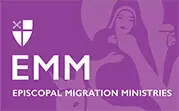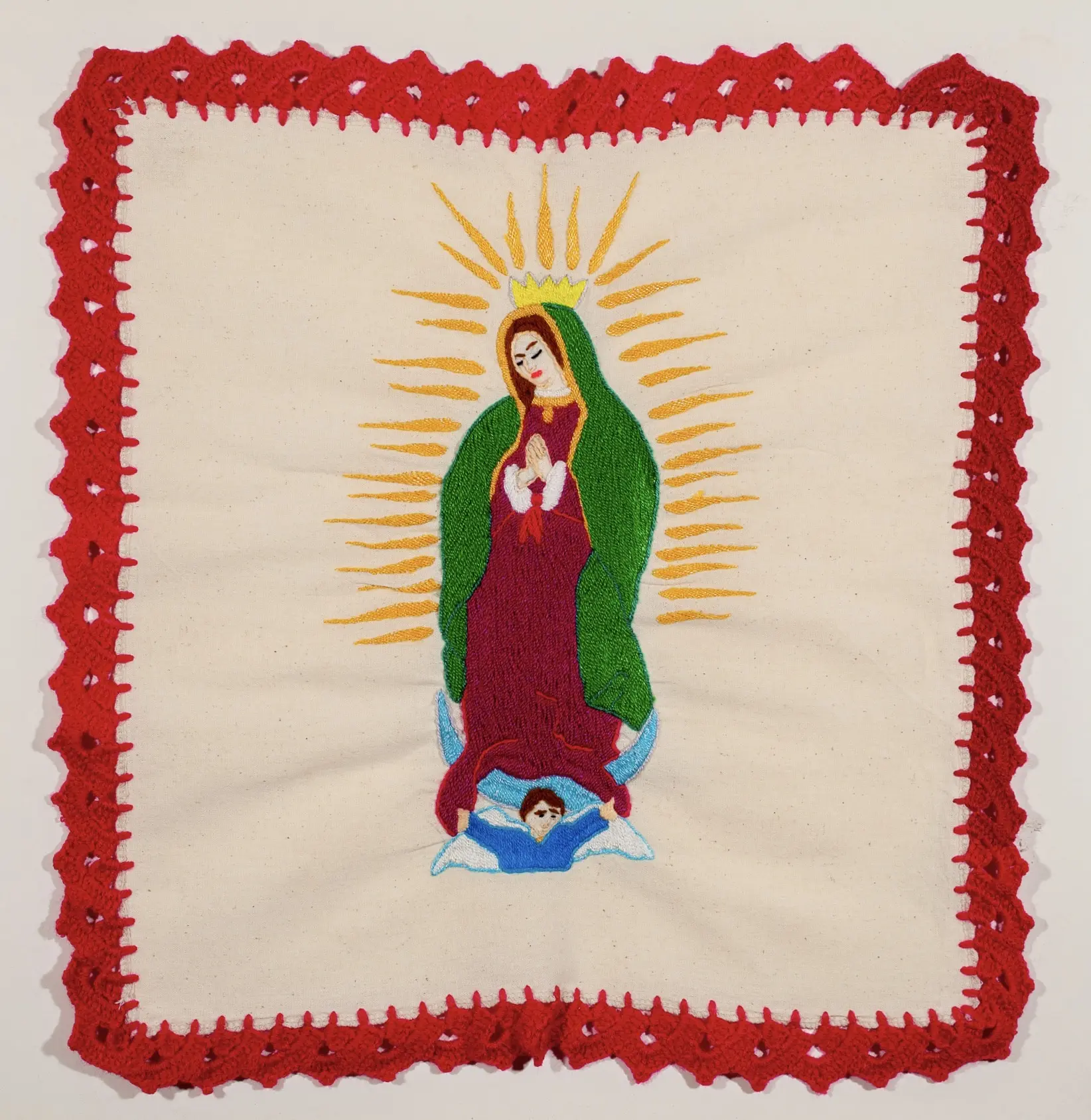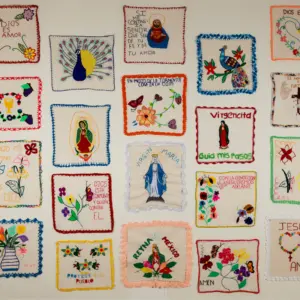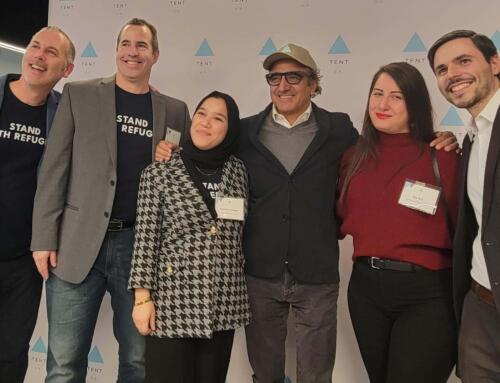
Devotional Embroidery by Asylum-seeker Selene Maldonado
Reflection by Valarie Lee James
When asked what inspires her, Selene Maldonado, our on-site coordinator in Nogales states pointedly: What I am, what I have lived, and what I like. The 31-year-old mother of three is vulnerable and strong in equal measure, and what she has lived through – the attempted murder of her husband, the father of her three children – is enough trauma for her and her kids for a lifetime. For Selene, thrown into forced migration, ripped and torn from all she knows, the act of embroidering, slow and steady, is a restoration of the soul.
Artisans Beyond Borders, (ABB) a bi-national ministry at Grace St. Paul’s Episcopal in Tucson, began in 2019 as a way to bring trauma-informed arts and activities to asylum-seekers and their families waiting in shelters and on the streets in Nogales, Sonora, Mexico. Now in 2021, in the shadow of politics and a pandemic, therapeutic arts and the dignity of artisanal craft continue to bring comfort to the traumatized and hope to asylum-seekers who have been in limbo for a year or more waiting for a chance to petition for asylum. Bordando Esperanza – Embroidering Hope, the flagship program, also helps restore personal agency and income through Etsy shop sales of the artisans’ original hand-embroideries.
As a Tucson ‘Friend of Artisans Beyond Borders,’ I’ve had the opportunity to develop friendships with many of the asylum-seekers in our program. Even while communicating across a closed border on WhatsApp (only), sensitive discussions about family and faith, truth and beauty, have brought me to tears more than once.
Relationships need time and care to develop and cross-border connections are especially tenuous. Yet, during the pandemic lock-down, enduring friendships have taken root and flowered through the universal experience of art and familial craft, a shared cultural bridge when language (including google translate), fails.
Not unlike the contemplative focus needed for fine embroidery, the more attention we can give each other, the more respect we confer. To take time to really see and appreciate original family-based craft accomplished in the most difficult circumstances imaginable is to listen to what’s beloved and cultivated by family everywhere: home and land, the fruits of harvest, and all aspects of the natural world left behind.
This is the border through the lens of bordado embroidery. Make no mistake, the truth is stitched in and through the “prettiest” embroideries. Read between the lines and you will hear this: Bienvenidos, Welcome to my world.
For those of us el otra lado, on the other side of the wall, Theologian Ceciclia Gonzalez -Andrieu, and author of Bridge of Wonder: Art as a Gospel of Beauty writes: “…the artist asks us to enter into their pain, aloneness, or devastation. If we open ourselves to their otherness, work that breaks our heart through beauty or its’ absence will increase our capacity for love and compassion…”
Selene’s mother stitched traditional manta cloth for servilletes to keep tortillas warm and also adorned the furniture with embroidery to beautify the home. Though Selene now coordinates the work of 15-30 artisans, she actually did not learn to embroider from her mother. She instead learned from her companeras at the San Juan Bosco Alberque, the oldest established shelter in Nogales that her family stayed in when they first arrived.
Selene learned by watching other women and men embroider for Artisans Beyond Borders. I liked it so I dared to do something, and I learned little by little. She’s deeply touched that her mother is proud of what she has managed to learn. Selene’s 17-year-old daughter Alyson has also learned to embroider and crochet and that makes Selene especially proud. She can keep busy without thinking so much about everything we’ve been through.

Selene Embroiders an original Manta
Selene and some of her companeras have since relocated to the safe and well-appointed La Casa Interfaith shelter run by the Episcopal Diocese of Arizona. They’ve had stability for many months now and the variety and skill level of their work has grown by leaps and bounds.
Artisans living between three different shelters and the streets, are evolving into self-organizing collectives, an outcome that we friends in Tucson had hoped for from the start. Working hand-in-hand with Aid partners in Mexico is a winning combination. Where we once provided U.S donated supplies for instance, now the artisans buy most of their own and share, empowering individual makers and supporting the local Nogales, Sonora economy.
Solidarity amongst makers from such diverse countries as Guatemala, El Salvador, Honduras, Cuba, and Nicaragua, has grown organically with time. We’ve learned to live together, to really know each other, and to empathize with each other. I love that through embroidery we have created a family bond.
Since the beginning of our program in 2019, a percentage of embroideries created would be devotional in nature, stitched with messages of faith, but since the pandemic, the number of devotional bordados quadrupled.
Selene had fallen away from her Catholic faith but migrating north she found herself practicing a ritual she had learned as a child. When we leave home, we would always entrust ourselves to God and to our Virgin de Guadalupe.
The first night we arrived in the forest, we had to sleep in the chapel. Standing in front of the crying virgin, I exclaimed why she had put us on this difficult path. After a month and a half, I dreamed of the virgin very close to me. I understand now that God’s times are the perfect ones and I accept the path that he has set us upon.
Like the quiet confidence in God that Selene has come to know and trust, this I know: As volunteers on the border, every time we truly connect with “the other”, it is we who are redeemed.
Gonzáles-Andrieu writes that “works of art can be redemptive if they help build communities of vision and renewed purpose… In the end, art that is redemptive will be so because it makes the promise of truth and the eternal awesomely felt.”
Many of the artisans more unconventional devotionals are felt testimonies of faith on the Border. Other devotional embroideries, embellished with traditional religious symbolism and iconography, are intimate visual prayers. They all can be seen in the group exhibit Bordando Esperanza – Embroidering Hope: Devotional Retablos of Asylum, available (only) as a virtual exhibit at this time.
The complete exhibit is included in the Artisans Beyond Borders Zoom presentations that allow viewers to accompany, witness and support the makers at the border. ABB Zoom presentations include the initiative’s inspiring Origin story, an audience Q & A, and a link to the Artisans’ marketplace.
To book a Zoom presentation for your congregation: https://artisansbeyondborders.org/events
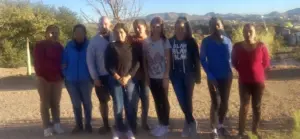
Embroiderers from Artisans Beyond Borders at La Casa shelter, Nogales, Sonora, Mexico
- Website: ArtisansBeyondBorders.org
- Shop: https://www.etsy.com/shop/BordandoEsperanza
- Newsletter/Blog: https://artandfaithinthedesert.com/
- FB: https://www.facebook.com/BordandoEsperanzaSinFronteras/
About the Author
Cultural Arts Worker Valarie Lee James, a longtime resident of the U.S.-Mexico borderlands, is the founder of Artisans Beyond Borders. A former Clinical Art Therapist, she was coordinator of the all-volunteer Trauma-informed Arts & Activities Program at Tucson’s Casa Alitas Migrant shelter, and co-curator of “Hope & Healing: The Art of Asylum” an exhibit of artwork by Casa Alitas migrant youth. She writes about Arts & Immigration at America Magazine, and as a Benedictine Oblate, contributes to The Global Sisters Report. Read about the Artisans “Profiles in Courage and Creativity” at Art and Faith in the Desert.
